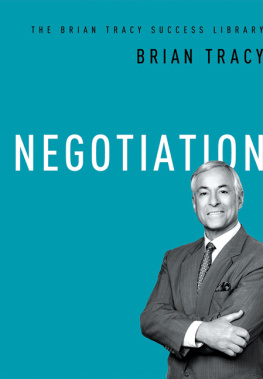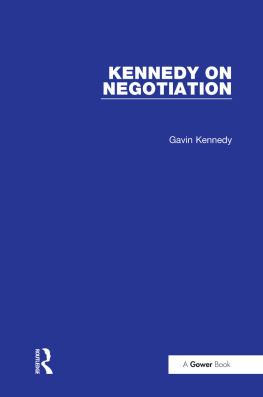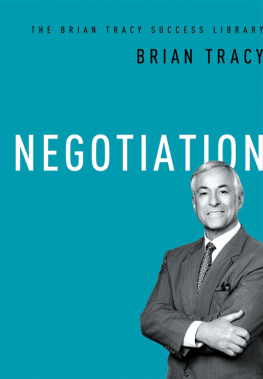Negotiation at Work
Maximize Your Teams Skills
with 60 High-Impact Activities
Negotiation at Work
Maximize Your Teams Skills
with 60 High-Impact Activities
Ira G. Asherman

Bulk discounts available. For details visit:
www.amacombooks.org/go/specialsales
Or contact special sales:
Phone: 800-250-5308.
Email: specialsls@amanet.org
View all the AMACOM titles at: www.amacombooks.org
This publication is designed to provide accurate and authoritative information in regard to the subject matter covered. It is sold with the understanding that the publisher is not engaged in rendering legal, accounting, or other professional service. If legal advice or other expert assistance is required, the services of a competent professional person should be sought.
Library of Congress Cataloging-in-Publication Data
Asherman, Ira.
Negotiation at work : maximize your teams skills with 60 high-impact activities / Ira G. Asherman. 1st ed.
p. cm.
ISBN 978-0-8144-3190-0
1. NegotiationStudy and teaching. I. Title.
BF637.N4A85 2012
658.4052dc23
2011046256
2012 HRD Press
All rights reserved.
Printed in the United States of America.
Portions of this book were published as 50+ Activities to Teach Negotiation, by Ira G. Asherman and 50 Activities for Sales Training by Philip Faris, both published by HRD Press, Inc.
Beach A & B scenarios on pages 225 and 227 are adapted from Negotiating Rationally by Max H. Bazerman and Margaret Nealie, Free Press, 1992, . The Boundary Role worksheet on pg. 257 is adapted from Interorganizational Negotiation and Accountability: An Examination of Adams Paradox by Cynthia S. Fobian, National Institute for Dispute Resolution, 1987. The worksheet for The Adams Paradox on pg. 261; adapted from The Structure and Dynamics of Behavior in Organizational Boundary Roles by J. S. Adams, Handbook of Industrial and Organizational Psychology, M.E. Dunnette, ed., Rand McNally, 1976.
Although this publication is subject to copyright, permission is granted free of charge to photocopy or download and print the pages that are required by each purchaser of this book. Only the original purchaser may make photocopies. Under no circumstances is it permitted to sell or distribute on a commercial basis material reproduced from this publication.
Except as provided above, this publication may not be reproduced, stored in a retrieval system, or transmitted in whole or in part, in any form or by any means, electronic, mechanical, photocopying, recording, or otherwise, without the prior written permission of AMACOM, a division of American Management Association, 1601 Broadway, New York, NY 10019
About AMA
American Management Association ( www.amanet.org ) is a world leader in talent development, advancing the skills of individuals to drive business success. Our mission is to support the goals of individuals and organizations through a complete range of products and services, including classroom and virtual seminars, webcasts, webinars, podcasts, conferences, corporate and government solutions, business books, and research. AMAs approach to improving performance combines experiential learninglearning through doingwith opportunities for ongoing professional growth at every step of ones career journey.
Printing number
10 9 8 7 6 5 4 3 2 1
CONTENTS
PDF files for the handouts and PowerPoint files for the overhead slides are
available to purchasers of this book at:
www.amacombooks.org/go/NegotiationWork
HANDOUTS AND OVERHEADS
www.amacombooks.org/go/NegotiationWork
HANDOUTS | Page Numbers |
OVERHEADS |
INTRODUCTION
Negotiation is an interactive activity that requires a variety of skills. It is not limited to the process of making concessions, offers, and counter offers. It requires self-awareness, good questioning, listening, and conflict resolution skills, as well as an ability to understand the needs and interests of others. We have therefore included exercises that cover all of these issues.
THE ORGANIZATION OF THIS BOOK
The exercises in this book are grouped by topic and presented in the following chapters.
Opening Activities (3 activities)
These activities are designed to open a negotiation program or to serve as pre-work materials. As pre-work materials, they begin the process of orientation before people arrive in the workshop.
Planning (2 activities)
These activities are designed to help people understand all the issues they need to consider when planning for a negotiation.
Creative Thinking (2 activities)
We find that many people are limited to yesterdays answers and are not creative in finding new ways to approach problems. These two activities are designed to address that concern.
Negotiation Skills (4 activities)
These activities are designed to look at the behaviors critical to being a successful negotiator.
Negotiating Styles (3 activities)
These activities are designed to help look at how we deal with conflict. They are best used in conjunction with negotiating styles or conflict resolution feedback surveys.
Assertiveness (3 activities)
These exercises are closely related to the styles section and are designed to show the relationship between assertive behavior and successful negotiation.
Questioning Techniques (3 activities)
Critical for all negotiators is the skill of questioning. These three exercises are designed to help participants practice this skill.
Ranking Exercises (3 exercises)
These three exercises stimulate discussion on issues specific to negotiation.
Surveys (2 activities)
These surveys are designed to help people evaluate their current skills. They can also be used to initiate a program. The surveys are self-scoring.
Case Studies (12 cases)
These cases address a variety of issues unique to negotiation. They can be used to support a range of learning objectives.
Negotiation Transcripts (4 transcripts)
These scripts are taken from several negotiation audios and videos we developed. We have also used them, without the videos, as case studies. They are valuable, since each explores the actual dialogue of a negotiation. Tapes of the transcripts are also available.
General Exercises (4 activities)
These exercises can be used in a variety of places in a program. Some are designed to support specific exercises in your program.
Needs and Interests (2 activities)
These activities are designed to help look at ones needs and interests, as well as those of the other party.
Difficult People (1 activity)
This exercise is designed to help participants practice dealing with difficult people.
Boundary Roles (3 activities)
These three activities are best when used with people who serve in a boundary role function. They explore the boundary role concept and its implications.
Sales Negotiation (10 activities)
These materials are designed specifically to present issues unique to the sales function.
THE ORGANIZATION OF THE ACTIVITIES
Next page







